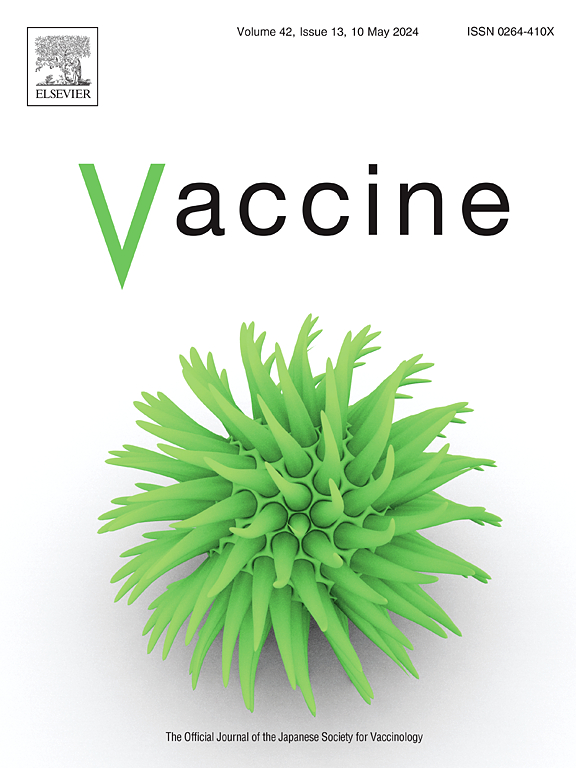Understanding the decline in HPV vaccination in Colombia: A population-based analysis of girls and parents in early rollout cohorts
IF 4.5
3区 医学
Q2 IMMUNOLOGY
引用次数: 0
Abstract
Many countries in the world are facing challenges to reach the WHO proposed target of HPV vaccination of 90 % of girls by the age of 15. A population-based cross-sectional survey was conducted in Manizales, Colombia to identify sociodemographic factors and components of the health belief model related to HPV vaccination in the 2003, 2004, and 2005 birth cohorts of girls and their parents targeted by the national HPV vaccination program in 2012, 2013, and 2014. Complementary log-log generalized linear models were used to obtain adjusted Prevalence Ratios (aPR) and 95 % confidence intervals (CI). A lower prevalence of HPV vaccination was observed in girls of the 2004 (aPR 0.82; 95 % CI 0.71–0.92) and 2005 (aPR 0.61; 95 % CI 0.52–0.71) cohorts compared to the 2003 cohort. The higher scores of perceived benefits by girls (aPR 1.06; 95 % CI 1.05–1.08) or their parents (aPR 1.05; 95 % CI 1.03–1.06) were associated to a higher prevalence of HPV vaccination of the girls. Conversely, this prevalence decreased with perceived barriers by girls (aPR 0.94; 95 % CI 0.91–0.96) and parents (aPR 0.91; 95 % CI 0.88–0.94). Parent's education lower attainment, lower socioeconomic stratum, and subsidized (public) health insurance were related to decreased likelihood of HPV vaccination. The results suggest that campaigns for HPV vaccination require effective education strategies to improve public perception of the vaccine's safety and benefits. Decision-makers and implementers must address also other social determinants such as disparities in access to education by parents, the SES, and the type of health insurance to improve HPV vaccination coverage.
了解哥伦比亚HPV疫苗接种率下降的原因:对早期接种队列中的女孩和父母进行的基于人群的分析
世界上许多国家在实现世卫组织提出的到15岁为90%的女孩接种人乳头瘤病毒疫苗的目标方面面临挑战。在哥伦比亚马尼萨莱斯进行了一项基于人群的横断面调查,以确定2003年、2004年和2005年出生的女孩及其父母接种HPV疫苗相关的社会人口学因素和健康信念模型的组成部分,这些女孩及其父母是2012年、2013年和2014年国家HPV疫苗接种计划的目标人群。互补对数-对数广义线性模型用于获得校正患病率(aPR)和95%置信区间(CI)。2004年女孩HPV疫苗接种率较低(aPR 0.82;95% CI 0.71-0.92)和2005年(aPR 0.61;95% CI 0.52-0.71)队列与2003年队列相比。女生的利益感知得分较高(aPR为1.06;95% CI 1.05 - 1.08)或其父母(aPR 1.05;95% CI 1.03-1.06)与女孩HPV疫苗的较高流行率相关。相反,这种患病率随着女孩感知到的障碍而下降(aPR 0.94;95% CI 0.91 - 0.96)和父母(aPR 0.91;95% ci 0.88-0.94)。父母受教育程度较低、社会经济阶层较低和有补贴的(公共)健康保险与HPV疫苗接种可能性降低有关。结果表明,HPV疫苗接种运动需要有效的教育策略,以提高公众对疫苗安全性和益处的认识。决策者和实施者还必须解决其他社会决定因素,如父母教育机会的差异、社会经济地位和健康保险类型,以提高HPV疫苗接种覆盖率。
本文章由计算机程序翻译,如有差异,请以英文原文为准。
求助全文
约1分钟内获得全文
求助全文
来源期刊

Vaccine
医学-免疫学
CiteScore
8.70
自引率
5.50%
发文量
992
审稿时长
131 days
期刊介绍:
Vaccine is unique in publishing the highest quality science across all disciplines relevant to the field of vaccinology - all original article submissions across basic and clinical research, vaccine manufacturing, history, public policy, behavioral science and ethics, social sciences, safety, and many other related areas are welcomed. The submission categories as given in the Guide for Authors indicate where we receive the most papers. Papers outside these major areas are also welcome and authors are encouraged to contact us with specific questions.
 求助内容:
求助内容: 应助结果提醒方式:
应助结果提醒方式:


